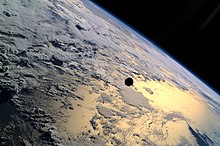| Mission type | Amateur radio satellite |
|---|---|
| Operator | USAF |
| COSPAR ID | 1998-064B |
| SATCAT no. | 25520 |
| Spacecraft properties | |
| Launch mass | 57 kg (126 lb) |
| Dimensions | 50 cm (20 in) |
| Start of mission | |
| Launch date | 30 October 1998, 17:20 UTC |
| Rocket | Space Shuttle Discovery STS-95 |
| Launch site | Kennedy LC-39B |
| Contractor | NASA |
| End of mission | |
| Last contact | 2003 |
| Orbital parameters | |
| Reference system | Geocentric |
| Regime | Low Earth |
| Eccentricity | 0.00072 |
| Perigee altitude | 551 km (342 mi) |
| Apogee altitude | 561 km (349 mi) |
| Inclination | 28.5° |
| Period | 95.8 minutes |
| Epoch | 30 October 1998 |
| OSCAR← OSCAR 33OSCAR 35 → | |
PANSAT (Petite Amateur Navy Satellite, also known as OSCAR 34) was an amateur radio satellite. It was launched by Space Shuttle Discovery during the STS-95 mission as part of the third International Extreme Ultraviolet Hitchhiker (IEH-3) mission, on 30 October 1998 from Kennedy Space Center, Florida.

The satellite was built by students from the Naval Postgraduate School in Monterey, California. It offered the possibility of packet radio transmission in BPSK or Direct-Sequence Spread Spectrum in the 70 cm band. The satellite was configured in a sphere-like shape, featuring 26 sides used for solar cell and antenna placement. The spacecraft supplied direct-sequence, spread-spectrum modulation with an operating center frequency of 436.5 MHz, a bit rate of 9600 bit/s and 9 MB of message storage.
References
- NASA Goddard Space Flight Center. "PANSAT". NSSDCA MAster Catalog. Retrieved 11 February 2020.
- EOPortal.org. "PANSAT". Retrieved 11 February 2020.
- Dirk Krebs, Gunter. "PANSAT (S97-D, PO 34, PANSAT-OSCAR 34)". Gunter's Space Page. Retrieved 13 Feb 2020.
- Martin, Donald H. (2000). Communication Satellites. AIAA. ISBN 978-1-884989-09-4.
| OSCAR satellites | ||
|---|---|---|
| Satellites |
|  |
This spacecraft or satellite related article is a stub. You can help Misplaced Pages by expanding it. |